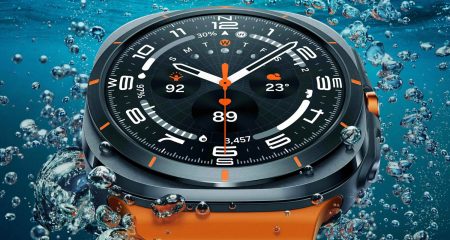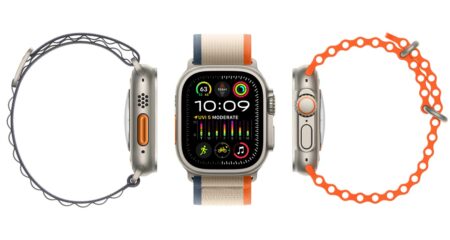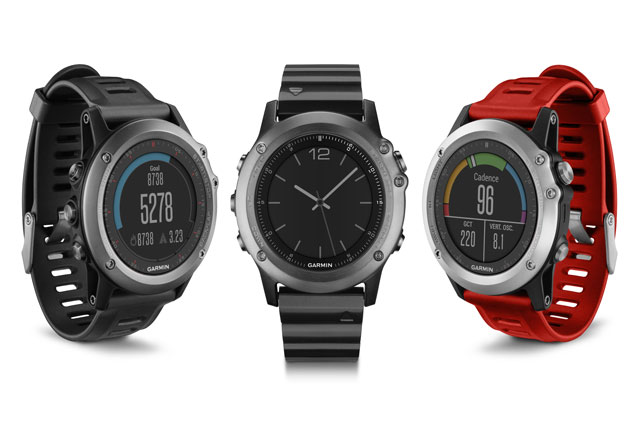
The problem with most GPS-enabled multi-sport watches is that they’re normally big, bulky and brash. This doesn’t seem to stop some endurance athletes from wearing them as their primary timepiece though — a bright orange, blue or white ostentatious statement that they take their training and racing seriously, and that standard fashion conventions don’t apply to them.
Thankfully, Garmin realised that not every active individual who owns a device of this nature, and who uses it as both their primary means of timekeeping and as a sports watch (they’re not that cheap as you’ll see), wants to announce to all and sundry that they’re a mild-mannered accountant by day and an unbridled running or cycling fiend on weekends.
To that end, the latest iteration of Garmin’s multi-sport device aimed at the active outdoor market — the Fēnix 3 — is packed full of all the features you want from a sports watch, with the added benefit of a more understated traditional watch design. And there are a host of added functions and features that have the potential to make this model the perfect all-rounder.
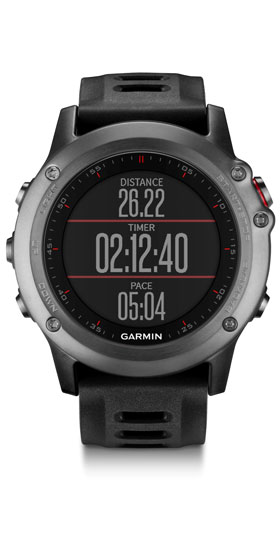 Rugged roots
Rugged roots
What started out as a GPS-enabled watch for the rugged outdoorsman, the third iteration of the Fēnix is certainly more refined. Initially aimed at the hiker, adventurer and ultra-trail runner, with the requisite ABC (altimeter, barometer and compass) functionality and 50 hours of claimed battery life, the Fēnix 1 was squarely aimed at taking on the incumbent GPS-enabled outdoor watch, the Suunto Ambit, which also offered some application as a sports tracker thanks to integration with a heart rate monitor.
Then came the Ambit 2, with the Fēnix 2 hot on its heels, both aimed at the burgeoning multi-sport market. These devices retained the features needed by orienteers, climbers and hikers, with added features to more effectively track swimming, cycling, running, or any combination of the three, as well as indoor training and a few other sporting codes that are largely irrelevant to South Africans.
The design of the Fēnix 2 retained the understated black facade of its predecessor, which worked as an everyday watch to a certain extent, although you’d be pushing your luck using it as a formal dress-wear accessory.
Everyday timepiece
Now we have the Fēnix 3, which is described by the manufacturer as a device “that combines practical, necessary function with contemporary style”.
Two variants are offered to suit different styles (and pockets). These are the Fēnix 3 Silver, priced at R7 599 (R8 449 for the performer bundle which includes the HRM-Run strap) and the Fēnix 3 Sapphire performer bundle, which is an eye-watering R9 999. When considered in the context of buying a traditional GPS-enabled sports watch, a certain degree of incredulity is understandable. But the truth is that this device is so much more.
The traditional round watch face has remained the core design feature for the range. Both devices sport a stainless steel bezel and are, without doubt the best looking watches in the Garmin line-up. The Silver option comes with a red strap and crystal lens, which was the version we received to test, while the premium Sapphire option comes standard with a stainless steel strap and domed sapphire lens.
The Fēnix 3 is also slightly thinner than its predecessor, giving it a sleeker form factor and a lighter overall weight and making it a slightly more comfortable watch for everyday use than the Fēnix 2. This has been achieved without compromising on battery life, which is still claimed to be up to 50 hours in UltraTrac mode. In full GPS mode, you should get up to 20 hours of battery life and up to six weeks in “smartwatch” mode. With combined use, including five hours in GPS mode and all the syncing required to download that volume of training data, I had to charge it near the end of the two-week period I had it on test.
The slimmer housing is also glass-fibre reinforced with stainless steel buttons (five of them — two on the right and three on the left), which give the device a waterproof rating of up to 100m. Additional features include a steel EXO antenna which receives both GPS and Glonass signals, and offers more protection for the watch in harsher, more rugged environments. The basic watch functions are also there, including alarms, tones, vibration alerts, timer and stopwatch.
Wearable technology
Aside from the design and styling upgrades from the Fēnix 2, the most important change for me has been the user interface — the watch face is bigger at 1,2 inches and it is now a high-resolution, 218×218-pixel Chroma colour display. This digital form of chronography enables users to switch between various watch face pre-sets on the device, or a number of downloadable watch faces from the Garmin Connect IQ app store.
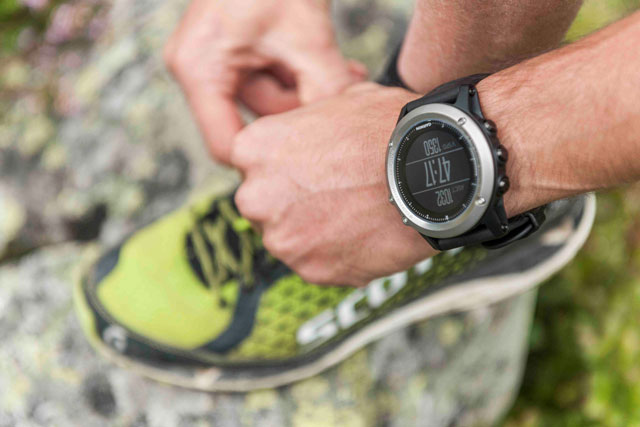
The traditional analogue watch face offers a more stylish touch for formal occasions, with digital watch face options that range from clean, clear and uncluttered to those that downright drown you in information. The “busier” option I tried included an altitude graph, temperature, time and date info all on one screen.
A nice touch is the ability to accent the watch face, changing colours on the hour or second hand in the analogue face or the hour and second digits in the digital face. Some of the colours are quite light, which makes them difficult to read in direct sunlight, but with the right contrast and colour combo the screen is easily read in bright outdoor conditions.
Smart(ish) features
The Fēnix 3 is also billed as a smartwatch in PR and marketing collateral but, much like the Vivoactive (read our review here), its major failing in this regard is a lack of interaction from the device itself.
Also, the “smart” features are only available when it is paired to a compatible smartphone via Bluetooth. However, the Fēnix 3 does offer Wi-Fi connectivity, allowing users to sync and update wirelessly to Garmin Connect after an activity. However, the Wi-Fi SSID connection needs to be set up through the Garmin Express interface on a Mac or PC. It can’t be done on the device out of the box.
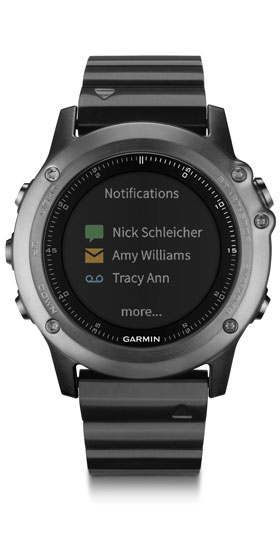 When it is paired with a device — an iPhone 5s in this instance — you get on-screen notifications of incoming calls, e-mails, calendar reminders and weather forecasts, among others. However, the depth of smartwatch-like functionality goes much further than that with the ability to download an ever-growing number of apps from the Garmin Connect IQ app store. At the time of writing, Garmin had just announced that the number of apps available had surpassed the thousand mark. While that pales in comparison to the established ecosystems of the main smartwatch manufacturers, the trend is definitely on the up.
When it is paired with a device — an iPhone 5s in this instance — you get on-screen notifications of incoming calls, e-mails, calendar reminders and weather forecasts, among others. However, the depth of smartwatch-like functionality goes much further than that with the ability to download an ever-growing number of apps from the Garmin Connect IQ app store. At the time of writing, Garmin had just announced that the number of apps available had surpassed the thousand mark. While that pales in comparison to the established ecosystems of the main smartwatch manufacturers, the trend is definitely on the up.
And it is a combination of these apps that give the Fēnix 3 the added dimension of also being an activity tracker. Users can customise step goals, be it number of steps or distance covered, and they’ll get on-screen prompts to tell them how they’re doing. Regular vibration alerts and an on-screen colour-coded graphic representation of your progress ensures you keep moving if you’re stationary or seated for too long.
The device also offers the same level of sleep tracking as the Vivoactive, but one night of sleeping with a full-sized watch on my wrist was enough to know that there are better ways to track sleep quality and duration, particularly as the metrics it tracks aren’t very granular.
Outside of that, notifications are generally easy to read on the screen. You still need to scroll down to get an entire message and you can’t engage via the watch interface but you wouldn’t really expect that level of integration from a device that isn’t a dyed-in-the-wool smartwatch.
The Fēnix 3 also integrates with the Garmin Virb Elite action camera via an Ant+ connection. When paired, users will have basic wrist-based operating functionality such as starting and stopping recording, or taking stills.
Big data
However, what it lacks in terms of smartwatch functionality it certainly makes up for in its sports tracking capabilities. Whichever sports mode you select, the navigational toolset in the Fēnix 3 won’t leave you short on feedback. The dual GPS and Glonass tracking is paired with a barometer, auto-calibrating altimeter and a three-axis electronic compass to deliver highly accurate tracking.
It also seems to locate and connect with a signal a lot quicker than my Fēnix 2, particularly in a crowd of runners at the start of race, many of whom are also trying to connect with other devices. This usually wreaked havoc with the other GPS-enabled devices I’ve owned and tested, but the Fēnix 3 seemed to have little trouble.
While I didn’t get a chance to traverse the rugged terrain this watch was designed for, a gentle stroll through Delta Park in Johannesburg gave me a chance to try out some of the navigational features. With this watch you can plan trips and navigate courses, mark locations, and record a GPS “breadcrumb trail” while on the move. Then, using the TracBack feature, you can navigate back along the route you followed initially, to get back to your starting point. The on-screen map is easy to read and follow, and was surprisingly detailed.
Sports tracking
The true value of this device wrests in its sport tracking capabilities, even more so as an avid road and trail runner. The Silver performer bundle I had on review included the HRM-Run strap, which has the ability to deliver the type of metrics that make wannabe sport scientists salivate.
When paired with the HRM-Run, the Fēnix 3 can estimate VO2 max, which is an important indicator of current fitness levels, as well as your performance potential. Granted, the accuracy of this figure does rely on the user inputting accurate resting and maximal heart rate values, so to get the most accurate information from the watch I would suggest investing in a proper fitness test to establish your exact baseline values.
Based on your estimated VO2 max, the watch is also able to predict race times over the 5km, 10km, half marathon and full marathon race distances. I feel it is rather generous and I am yet to get close to any of the predicted times, but it is worth bearing in mind that those times would only be possible in perfect conditions — flat route (not many of those in South Africa) and cool temperatures, to name a few. It also doesn’t take into account other important variables such as your weight, muscle fibre composition and lactate thresholds, which all materially affect your performance potential, but enough with the sport science. Either way, an estimate of what is conceivably possible certainly inspires me to push a little harder to reach those lofty goal times.

Additional running metrics that have proven invaluable to me in terms of improving my running efficiency and economy over the last two years (using my Fēnix 2) have been Garmin’s advanced running dynamics, which track cadence, vertical oscillation height and ground contact time.
There is also a metronome feature that delivers audible or vibration alerts when conducting running cadence drills, which is an extremely useful feature for anyone working to improve their running technique.
When uploaded to the Garmin Connect website — if you’re new to the Garmin ecosystem you’ll need to register an account, download the app for iOS or Android devices, and set up the device using Garmin Express – you’re able to view and correlate your values with the recommended ranges to see how you compare and what percentile you’re currently categorised in. While the more analytically inclined may argue about the accuracy of these figures, using this information to improve running form will certainly help most runners to some extent.
The Fēnix 3 will also give you an estimated recovery time, in hours, after each session based on your effort and intensity of your session (based on measured heart rate and time spent in specific heart rate zones) and the duration of that session. It also performs a “recovery check” at your next session, also based on heart rate and will indicate on the screen if your recovery has been “poor” or “good”. These are two more extremely helpful features that will give the average runner deeper insight into their training.
With its heritage as the ultimate device for the rugged adventurer, this device is also a favourite among trail runners, and Garmin has taken cognisance of this fact. For instance, in trail running mode, the “Auto-Run-Climb” feature will switch between displays to share relevant data based on the terrain you’re currently on. This means that when a runner is climbing, an odometer allows them to track ascent performance.
When paired with a smartphone that has the Garmin Connect mobile app, and there is reliable network coverage in the area, users can also make use of the LiveTrack function, which allows family and friends to track your progress during a training session or race.
If running is not your thing, then don’t worry: the watch supports a full range of sports, from general fitness activities, to skiing, snowboarding, cycling and swimming. Of course, it also has a multi-sport function which makes it suitable for triathletes. The device can also integrate with a whole host of Ant+-enabled peripherals for added metrics like power meters or foot pods.
Final thoughts
Although this device is packed full of features, there are specialised, fit-for-purpose devices in the Garmin range for various individual sports that are probably worth considering before you buy a Fēnix 3, especially if any of them are your main focus.
However, if you’re someone who does a bit of everything, particularly adventurous outdoor-type activity in the “bundus” or serious trail running, and you’re also looking for a watch that wouldn’t look out of place at a business meeting, then either of the Fēnix 3 devices are definitely worth considering. Pricing is also comparable with its main rival, the Suunto Ambit 3 Sapphire, which costs R8 999 for the HR bundle.
- Review unit supplied by Garmin Southern Africa
- Pedro van Gaalen is the editor of Fitness His Edition magazine


